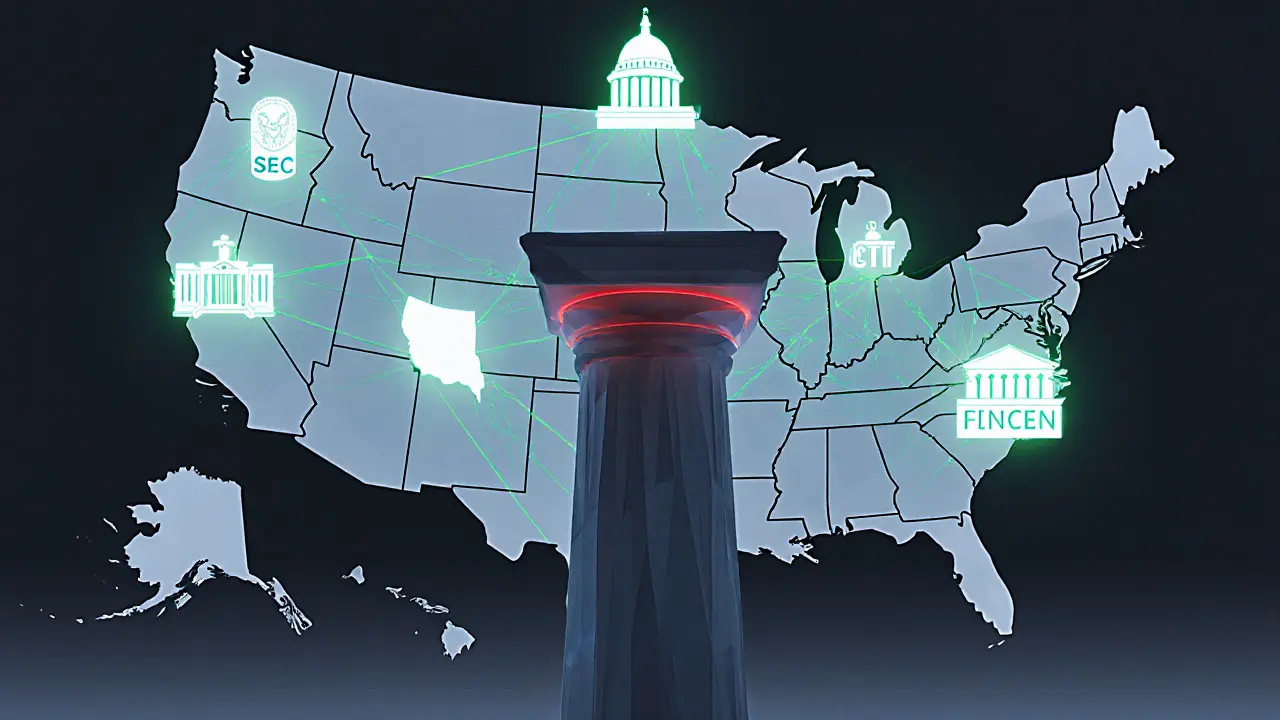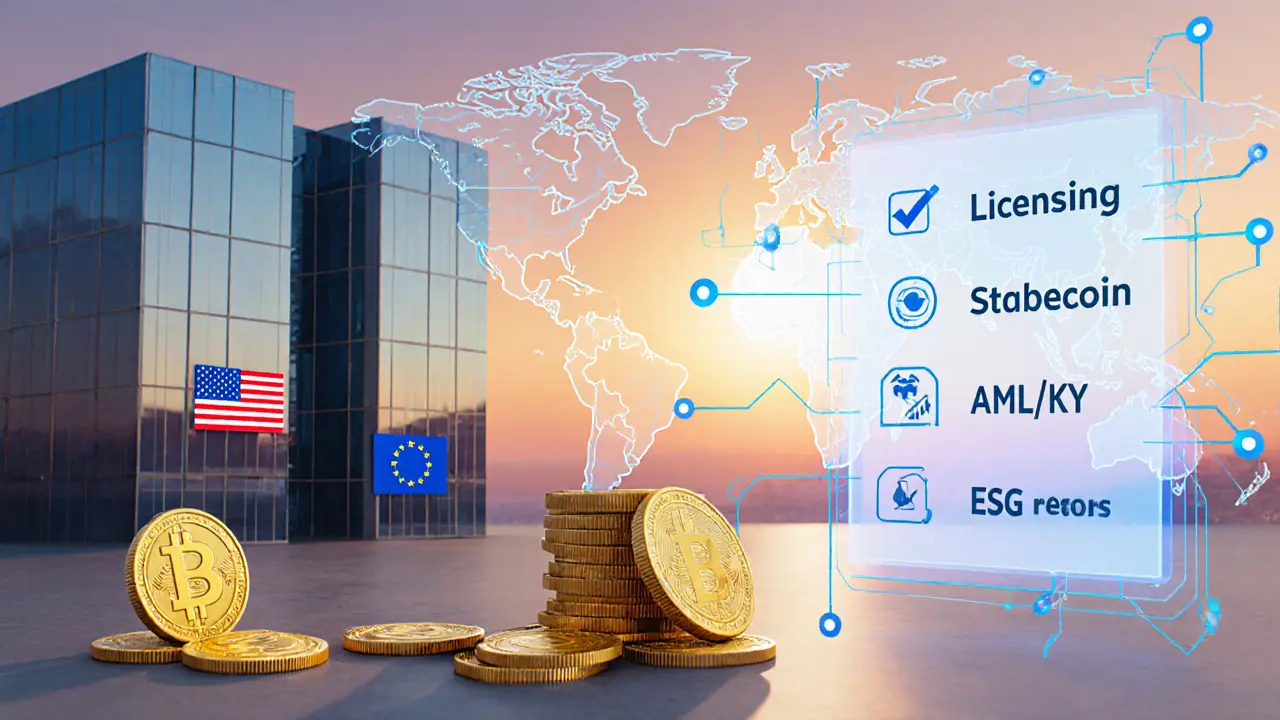How Crypto Trading Regulation Varies Between the US and EU in 2025

Crypto Regulation Comparison Tool
Select token type and jurisdiction, then click "Compare Regulations" to see detailed compliance requirements.
United States
- SEC - Regulates securities
- CFTC - Regulates commodities
- FinCEN - Travel Rule compliance
- State - Additional licensing requirements
European Union
- MiCA - Unified framework
- ESG - Sustainability reporting
- FATF - Travel Rule compliance
- National Authorities - Local supervision
Regulatory Differences for Crypto Trading refers to the contrasting legal frameworks that govern digital‑asset trading across countries and regions. In 2025 the divide is stark: the United States runs a fragmented, agency‑by‑agency system, while the European Union works under a single, comprehensive code called MiCA. If you’re a trader, platform operator, or investor, understanding these gaps is the first step to staying compliant and avoiding costly fines.
Quick Take
- US crypto rules are split between the SEC (securities) and the CFTC (commodities), plus a growing patchwork of state licences.
- The EU’s MiCA provides a unified licensing regime for all crypto‑asset services and tokens.
- Travel Rule compliance in the US triggers reporting for transfers of $3,000 or more, while the EU follows FATF standards without a fixed monetary threshold.
- Recent US bills - the GENIUS Act and the Digital Trading Clarity Act - aim to reduce uncertainty but still rely on case‑by‑case classifications.
- For cross‑border operators, a compliance checklist that covers licensing, AML, and ESG reporting can save weeks of legal back‑and‑forth.
US Regulatory Landscape
United States does not have a single federal crypto law; oversight is distributed across multiple agencies. The two main federal bodies are:
- Securities and Exchange Commission (SEC) regulates digital assets that are deemed securities.
- Commodity Futures Trading Commission (CFTC) covers assets classified as commodities under the Commodity Exchange Act.
The split creates constant courtroom drama. In 2025, Judge Torres (Southern District of New York) ruled that only institutional sales of XRP count as securities, while Judge Rakoff (Southern District of New York) declared Terraform’s UST stablecoin a security. Those decisions illustrate how classification can swing the regulatory pendulum from one agency to the other.
On the AML front, the Financial Crimes Enforcement Network (FinCEN) enforces the Bank Secrecy Act’s Travel Rule for virtual asset service providers (VASPs). Any transaction of $3,000+ must capture the originator’s and beneficiary’s name, address, wallet address, and the financial institution involved. Failure to transmit that data can trigger civil penalties exceeding $1million per violation.
State‑level rules add another layer. For example, the Louisiana Virtual Currency Business Act requires anyone conducting virtual‑currency business in the state to obtain a licence or qualify for specific exemptions. Each state can impose its own reporting cadence, licensing fees, and consumer‑protection standards, turning the US into a 50‑jurisdiction maze.
EU Regulatory Landscape - MiCA
The European Union took a opposite route. The Markets in Crypto‑Assets Regulation (MiCA) is a continent‑wide framework that became fully applicable in December2024. MiCA covers three token categories:
- Electronic Money Tokens (EMTs) - pegged to fiat and used for payments.
- Asset‑Referenced Tokens (ARTs) - linked to a basket of assets.
- All other crypto‑assets, including utility tokens.
Under MiCA, any firm that issues EMTs or ARTs must hold either an e‑money licence or a full banking licence. This gives traditional banks a built‑in advantage: they can provide custody, exchange, and payment services all under one supervisory umbrella. In contrast, a US‑based crypto exchange would need separate registrations with the SEC, CFTC, and possibly state regulators.
MiCA also enforces strict AML and ESG obligations. The European Commission plans to fold crypto‑mining activities into the EU taxonomy regulation, meaning firms must disclose energy consumption and align with sustainability goals-requirements that are still optional in most US jurisdictions.

Key Compliance Areas: AML, Travel Rule, and Licensing
Both regions follow the Financial Action Task Force (FATF) recommendations, but the implementation differs.
| Aspect | United States | European Union (MiCA) |
|---|---|---|
| Transaction threshold | $3,000 (FinCEN) | No fixed amount; applies to all cross‑border VASP transfers per FATF |
| Data required | Name, address, wallet address, financial institution, amount, date | Name, address, wallet address, transaction hash, amount |
| Enforcement body | FinCEN & state regulators | National competent authorities (e.g., BaFin, AMF) |
| Penalty range | Up to $1M per violation | Up to €5M or 5% of annual turnover |
Beyond AML, licensing is the biggest hurdle. In the US, a crypto‑exchange that lists a token deemed a security must register as a national securities exchange or operate under an exemption, a process that can take 12‑18 months. In the EU, once the firm secures an e‑money licence, it can issue EMTs and provide a full suite of services without separate securities registration.
Recent US Legislative Moves
Two bills released in 2025 try to bring some clarity:
- GENIUS Act creates a bipartisan framework for stablecoins, defining them as a new asset class and mandating reserve reporting. The act aligns partially with MiCA’s asset‑referenced token rules but adds a U.S.‑specific “reserve‑backing” audit every quarter.
- Digital Trading Clarity Act offers a two‑year safe harbor for platforms that list assets later classified as securities, provided they cooperate with the SEC. This reflects the US preference for case‑by‑case decisions rather than pre‑emptive regulation.
Both bills still need to navigate the SEC‑CFTC turf war, but they signal a shift toward more predictable rules for crypto‑trading platforms.
How the Differences Impact Traders and Platforms
If you run a global exchange, the practical fallout looks like this:
- Licensing cost: In the EU, a single e‑money licence can cost €200k‑€500k annually. In the US, you may face separate SEC registration fees ($100k+), CFTC reporting costs, and up to 30 state licences, each with its own fee schedule.
- Product design: A token that qualifies as an ART in Europe can be issued with a banking licence, but the same token might be treated as a security in the US, forcing you to file a prospectus.
- Operational speed: EU regulators provide a 12‑month “grace period” for compliance after MiCA’s launch, while US agencies can issue cease‑and‑desist letters within days of a perceived violation.
- Risk of double‑taxation: US‑based platforms serving EU customers must reconcile differing AML reporting formats, potentially duplicating effort and increasing error risk.
The bottom line: the US model rewards agility and state‑level innovation, but it punishes anyone who needs a uniform, cross‑border framework. MiCA rewards consistency and scale, yet it can be expensive for newcomers without a banking partner.
Practical Compliance Checklist for Global Operators
- Identify token classification: Run a jurisdiction‑by‑jurisdiction test to see if your token falls under securities, commodities, or EMT/ART categories.
- Secure the appropriate licence: In the EU, apply for an e‑money licence before issuing EMTs. In the US, file Form S‑1 or a CFTC notice as needed.
- Implement Travel Rule tech: Use a VASP‑compliant API that can capture and transmit required data for $3,000+ transfers (US) and for all cross‑border transfers (EU).
- Set up AML/KYC pipelines: Integrate ID‑verification, sanctions screening, and transaction monitoring that meet both FinCEN and national EU authority standards.
- Prepare ESG reporting (EU only): Track energy consumption of any mining or staking operation and map it to the EU taxonomy.
- Monitor legislative updates: Track the progress of the GENIUS Act, Digital Trading Clarity Act, and any state‑level amendments.
- Maintain documentation: Keep audit‑ready records of token issuance, reserve holdings, and compliance checks for at least five years.
Following this checklist can shave weeks off the onboarding process and keep your platform out of regulator‑hand‑cuffs.

Frequently Asked Questions
What is the main difference between US and EU crypto regulation?
The US relies on separate agencies (SEC, CFTC, FinCEN) and state licences, creating a fragmented system. The EU uses a single, pre‑emptive framework called MiCA that standardises licensing, AML, and token classification across all member states.
Do I need a separate licence to issue a stablecoin in Europe?
Yes. Under MiCA, stablecoins that are classified as Asset‑Referenced Tokens require an e‑money or banking licence before they can be issued or distributed.
How does the US Travel Rule differ from the EU’s approach?
The US sets a $3,000 transaction threshold and mandates specific data fields under FinCEN. The EU follows the FATF standard without a fixed monetary limit, applying the rule to all cross‑border VASP transfers.
What impact does the GENIUS Act have on US traders?
It clarifies that stablecoins are a distinct asset class, requires quarterly reserve audits, and provides a clearer path for platforms to list stablecoins without immediate SEC enforcement, though it still leaves room for case‑by‑case rulings.
Can a US exchange operate in the EU without a banking licence?
Only if it limits its services to non‑regulated tokens (e.g., utility tokens) and does not issue EMTs or ARTs. Offering any regulated token or wallet‑custody service will trigger the need for an e‑money or banking licence under MiCA.

Kate Roberge
May 18, 2025 AT 05:01Wow, another buzzword‑filled breakdown of US vs EU crypto law, and yet you’re still missing the point that regulators love ambiguity because it fuels their power grabs. I mean, sure, the US has a “fragmented” system, but that’s just an excuse for states to line their pockets with licensing fees. Meanwhile, the EU pretends its single MiCA framework is a utopia, ignoring the fact that it forces small startups into banking‑licence nightmares. If you think compliance checklists are the answer, you’re basically handing regulators a recipe book for more fines. Bottom line: both sides are playing chess while the rest of us are stuck moving pawns.
Jason Brittin
May 20, 2025 AT 12:34Oh great, another “quick take” that pretends the US is a chaotic mess and the EU is some regulatory fairyland 🙃. If only they’d tell us how to actually file those endless forms without turning our coffee into a nervous breakdown. At least the GENIUS Act sounds like a decent meme, right? 😂
MD Razu
May 22, 2025 AT 20:08When we contemplate the ontological ramifications of a jurisdictional divide, we must ask whether law itself is a living organism adapting to the chaotic flux of digital assets. The United States, with its polyphonic chorus of agencies, embodies a federalist symphony where each instrument-SEC, CFTC, FinCEN-plays its own discordant melody, creating a cacophony that paradoxically protects and stifles innovation. In contrast, the European Union attempts to harmonize this discord into a singular concerto, MiCA, striving for a unison that may at once silence the outliers and mute the avant‑garde. Yet, one cannot ignore that both systems are bound by the immutable principle of power: the ability to define what constitutes a “security” or a “commodity” ultimately rests in the hands of those who wield legislative authority. Thus, the trader is caught between the Scylla of regulatory uncertainty and the Charybdis of compliance cost, forced to navigate a labyrinth that is as much about political will as it is about technical specification. The reality is that every token, whether a utility, stablecoin, or asset‑referenced instrument, becomes a philosophical artifact, a mirror reflecting our collective anxieties about sovereignty, trust, and value. Therefore, the true battle is not merely legal-it is an existential one, questioning what we deem worthy of trust in a digitized economy.
VICKIE MALBRUE
May 24, 2025 AT 13:48Good point thank you.
Michael Wilkinson
May 26, 2025 AT 15:48You’re oversimplifying the whole mess. The US isn’t just “fragmented”; it’s a battlefield where each state drops its own regulatory landmines. If you think a single licence in Europe solves everything, you’re naïve. Wake up and read the fine print before you brag.
april harper
May 28, 2025 AT 20:34Honestly, the whole comparison feels like a Broadway drama where the US plays the villain and the EU the savior, but the audience is left guessing who actually holds the script. The “single licensing regime” sounds glorious until a fledgling startup realizes they need a banking licence to even whisper about stablecoins. Meanwhile, the US’s “case‑by‑case” approach is just a fancy way of saying “we’ll keep you waiting”. In the end, it’s all just a spectacle of power and paperwork.
Carl Robertson
May 31, 2025 AT 04:08Let’s be real: both sides are just dressing up their bureaucratic greed with buzzwords. The US loves its “state licences” because each state gets a slice of the compliance pie, and the EU loves MiCA because it can claim uniformity while actually forcing small players into costly banking partnerships. The real victims are the developers who have to navigate this labyrinth of legalese while trying to build something innovative. And don’t even get me started on the “travel rule” – it’s essentially a surveillance tool masquerading as anti‑money‑laundering. So, congratulations, regulators, you’ve succeeded in turning crypto into a regulatory nightmare.
Waynne Kilian
June 2, 2025 AT 14:28i think the post misses the point that regulaton is not just about law but about how it impacts real people wec each day.
the us systme s treads a fine line between protecting investors and stifling innovation, while eu seems to try to gove a one size fits all solution that might not fit anyone.
in reality, the best approach might be a hybrid model that learns from both sides.
Naomi Snelling
June 4, 2025 AT 08:08Ever wonder why the GENIUS Act appeared just when the big banks were lobbying for more control? It’s not a coincidence. They’re trying to create a centralized reserve system that they can monitor and manipulate.
Don’t be fooled by the “clearer path” narrative; it’s a trap.
Lindsay Miller
June 6, 2025 AT 07:21I get why this can feel overwhelming, especially if you’re just starting out. The key is to take it step by step and focus on one jurisdiction at a time. You’ll find that the rules become clearer the more you dig in.
Rajini N
June 8, 2025 AT 09:21For anyone looking to start a crypto platform, begin by mapping your token classification against both SEC and MiCA criteria. Identify whether your token falls under a security, commodity, EMT, or ART, then prioritize obtaining the appropriate licence. Make sure your AML/KYC stack can handle both FinCEN’s $3,000 threshold and the EU’s FATF‑wide requirements. Finally, keep a compliance calendar to track legislative updates, especially the progress of the GENIUS Act and Digital Trading Clarity Act.
Oreoluwa Towoju
June 10, 2025 AT 05:48Great summary, very clear. Thanks for the checklist!
Amie Wilensky
June 12, 2025 AT 05:01Honestly, the whole “US vs EU” debate feels like a perpetual drama, a stage where regulators wear masks, and every token becomes a character, forced to play roles assigned by law-sometimes a security, sometimes a commodity, sometimes an EMT, and the audience-us, the traders-are left to guess the script; the reality is that whether you’re in New York or Brussels, the cost of compliance is a relentless tide, crashing against startups, drowning those without deep pockets, and the only thing that saves you is a solid compliance framework, a clear token classification, and a relentless dedication to staying ahead of legislative changes.
Charles Banks Jr.
June 13, 2025 AT 22:41Wow, you really love commas, don’t you? It’s like a punctuation parade. Maybe tone it down next time.
Katrinka Scribner
June 15, 2025 AT 19:08Regulation is a rollercoaster, hold on tight! 🎢🚀
Billy Krzemien
June 17, 2025 AT 18:21Keep pushing forward, the compliance maze may look endless but each step you take builds resilience. Remember, the community is here to help you troubleshoot any roadblocks. Together we’ll turn those regulations into opportunities.
Clint Barnett
June 19, 2025 AT 20:21When you stare at the side‑by‑side comparison of US and EU crypto rules, the first thing that hits you is the sheer audacity of human institutions trying to cage something that was born digital. The United States, with its patchwork of agencies, reads like a choose‑your‑own‑adventure novel where each chapter ends in a new form filing. Meanwhile, the European Union’s MiCA attempts to write a single definitive guide, as if a single paragraph could tame a wild horse. Yet, in practice, both approaches produce a chorus of paperwork that sings the same lullaby of delayed launches. What’s fascinating is how the GENIUS Act tries to thread a needle through an ever‑tightening haystack of stablecoin definitions. The Digital Trading Clarity Act, on the other hand, offers a safe harbor that feels more like a revolving door to compliance teams. Traders, especially those operating cross‑border, end up juggling FinCEN’s $3,000 travel rule threshold alongside EU’s blanket FATF obligations, a juggling act that would impress even the most seasoned circus performer. Licensing costs become a new form of taxation, where European e‑money licences can drain half a million euros, while US state licences multiply like Lego bricks across the map. The ESG reporting mandates in the EU further add a green sheen to an already glittering compliance burden, forcing firms to measure carbon footprints of code. Conversely, the US’s lack of a unified ESG regime leaves companies to reinvent the wheel for each state, a testament to federalist freedom. The reality is that both systems are less about protecting investors and more about expanding bureaucratic reach, an ever‑expanding onion of rules that peel back only to reveal another layer. For startups, this means hiring legal counsel before even writing a line of code, a paradox for an industry built on decentralization. Yet, amid this chaos, opportunities arise for niche compliance solutions, third‑party APIs, and consulting firms ready to translate between the two worlds. In the end, the divergence is not a flaw but a feature, a test of resilience that separates fleeting hype from lasting innovation. So, if you can survive the regulatory gauntlet, you’ll emerge stronger, smarter, and ready to shape the next chapter of digital finance.